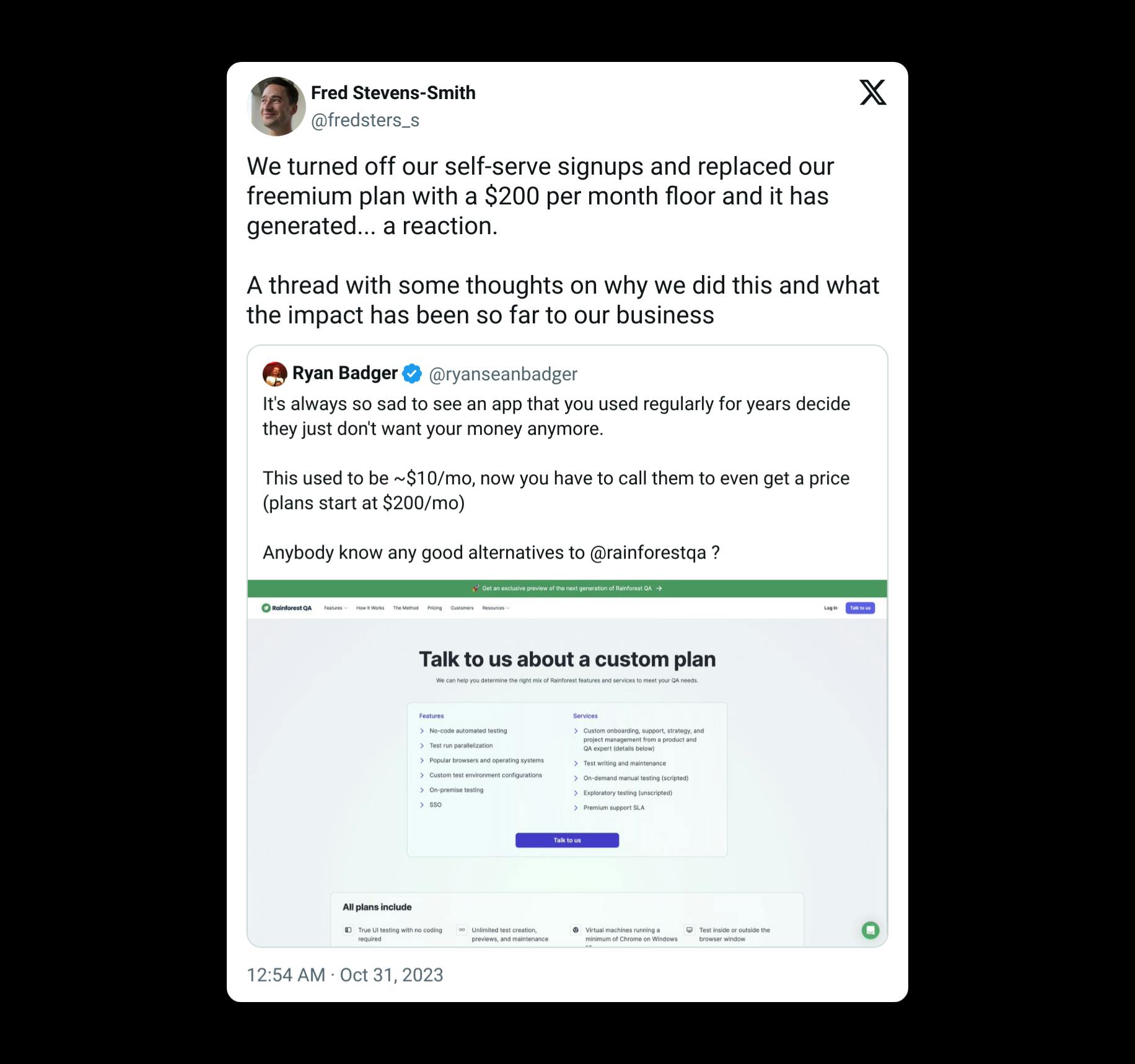I frequently analyze our company's experiences and what we see happening with other peers in our industry. By looking back and learning from these experiences, we improve and change our methods to keep up with the changing world of development tools.
When Fred Stevens-Smith, co-founder of Rainforest QA, shared his revelations about changes to their freemium model, it struck a chord with me—a recognition of the challenges and potential misalignments between product offerings and sustainable growth strategies.

The theory behind their original freemium product-led growth (PLG) model was that removing price obstacles by offering a free tier would widen the top of the funnel. However, they found that very few engineers organically grew from free to paid for their QA product. Most engineers willing to pay wanted more involved onboarding and paid a substantial amount upfront.
The free users were not converting and were draining business resources. So they made the change to require minimum spend. This generated $1 million in sales pipeline in 3 weeks, $100k closed, 10% of free users converted to paid, and 50% of existing customers converted to the new pricing.
Learning from PLG Challenges
There has been a common belief in the tech industry that adopting a Product-Led Growth (PLG) strategy can lead to quick user acquisition. This strategy often involves offering freemium tiers, which act as a way to attract potential paying customers. The underlying idea is that by removing the cost barrier, more users will be drawn into the product funnel. This belief is particularly prevalent in the context of developer tools, where allowing users to try the product without any financial commitment is thought to encourage organic growth.
The Developer Tool Dilemma
We ran Codeanywhere for fourteen years using this business model. Along the way, we learned that although developers love and use free products, they don't always have the power to make financial decisions. This creates a problem: even if developers like our product, it doesn't mean that businesses will invest in it.
Shift to A Value-Centric Model
As a result, we made changes to our approach and moved away from the freemium model to a value-focused one. As expected, this shift caused our user base to divide. However, this change in strategy led to an unexpected discovery: our revenue doubled.
This demonstrates that a product's true worth is often more important than the number of users it attracts.
PLG works well when the end-user has purchasing power, like with Dropbox. However, for enterprise products, PLG has serious limitations.
Founding Daytona: A Strategic Turnaround
Our experience with Codeanywhere taught us to pay attention to the market and user behavior. This knowledge has been crucial in shaping Daytona's core concept. Daytona is a platform that is built with a clear understanding of who the actual buyers are.
Instead of following the usual Product-Led Growth strategy, we chose a different approach. We focused on a targeted sales strategy that aims at the decision-makers as we understand how important it is to talk to the right people.
Tailored Approach for Sustainable Growth
Our strategy led to working with fewer clients, but those clients were willing to pay for proofs of concept (POCs). This approach brought in stronger revenue and also provided valuable feedback that helped us improve our product. It showed how important it is to match our business strategies with customers' needs.
Financing Insights: Investor Perception Shifts
During our fundraising, we saw different opinions from investors that highlighted the changing attitudes in the industry. Some investors were attracted to companies using the popular Product-Led Growth (PLG) approach. However, others liked Daytona's straightforward and sensible method, which focuses on businesses and offers a clear value proposition.
Daytona’s Future Trajectory
Our goals for Daytona go beyond just making a strong product. We aim for a future where development as a business function thrives. We're working towards a time when developers have access to environments that can grow and are secure, which will eliminate the constant problems with setup and security issues.
A Call for Thoughtful Innovation
As user expectations and market demands evolve, founders must carefully examine the Product-Led Growth (PLG) approach. PLG can be great for getting more users and encouraging them to use the product, but it won't work for every company, especially when the people who use the product aren't the ones who decide to buy it.
Therefore, a founder's strategic plan must include a rigorous evaluation of their customer's behavior, the product’s alignment with those behaviors, and the company's long-term revenue goals. A pivot from PLG to a model that emphasizes value and customer relationships may be necessary to ensure sustainable growth and the ongoing relevance of the business in a competitive marketplace.
Daytona represents a blend of careful consideration, dedicated effort, and forward-looking vision. We promise to stay aware of and react to the different needs of users and buyers, creating a story that combines deep understanding with strategic business sense. As we move forward, we invite you to join us in this exciting new phase of marketing developer tools—a new chapter where innovation is intentionally in tune with the real-world dynamics of user needs and business needs.




